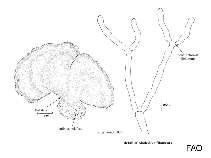Avrainvillea longicaulis (Kützing) G. Murray & Boodle
| Native range | All suitable habitat | Point map | Year 2050 |

|
| This map was computer-generated and has not yet been reviewed. |
| Avrainvillea longicaulis AquaMaps Data sources: GBIF OBIS |
Google image | No image available for this species;
drawing shows typical species in Udoteaceae.
Classification / Names Populärnamn | synonymer | CoL | ITIS | WoRMS
Bryopsidophyceae | Bryopsidales | Udoteaceae
Environment: milieu / climate zone / djupintervall / distribution range Ekologi
; djupintervall 0 - 30 m (Ref. 86695). Tropical
Distribution Länder | FAO områden | Ekosystem | Förekomster | Utplanteringar
Western Central Atlantic: Belize.
Length at first maturity / Size / Weight / Age
Könsmognad: Lm ? range ? - ? cm
Life cycle and mating behavior Könsmognad | Reproduktion | Lek | Eggs | Fecundity | Larvae
Main reference
referenser | Koordinator | Medarbetare
Hay, M.E., J.E. Duffy, V.J. Paul, P.E. Renaud and W. Fenical 1990 Specialist herbivores reduce their susceptibility to predation by feeding on the chemically defended seaweed Avrainvillea longicaulis. Limnology and Oceanography 35(8):1734-1743. (Ref. 86695)
IUCN Red List Status
(Ref. 130435: Version 2025-1)
CITES status (Ref. 108899)
CMS (Ref. 116361)
Threat to humans
Human uses
| FishSource |
Verktyg
Ytterligare information
Max. ages / sizes
Length-weight rel.
Length-length rel.
Length-frequencies
Mass conversion
Abundans
Könsmognad
Fecundity
Lek
Eggs
Egg development
Larvae
Internet-källor
BHL | BOLD Systems | CISTI | DiscoverLife | FAO(Publication : search) | Fishipedia | GenBank (genome, nucleotide) | GloBI | Gomexsi | Google Books | Google Scholar | Google | PubMed | AlgaeBase | Tree of Life | Wikipedia (Go, sök) | Zoological Record



